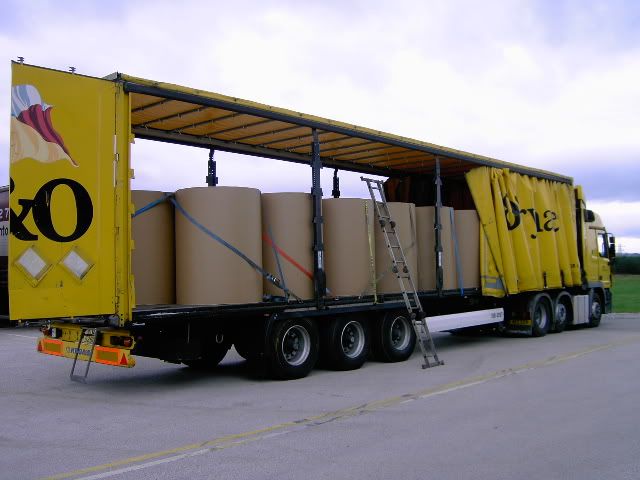Driveroneuk:

Ouch. That red strap pressing into the paper reel looks really nasty, meaning hefty claim coming from the consignee. But then, having no edge protectors it’s bit difficult to secure those without damage. Bad thing your trailer didn’t even seem to have any “woods” running alongside the curtain between “masts”, those can be used as “edge protectors” when you put those on top of the reels and pull strap over them, between the reels.
For original question, when loaded on the end, friction coefficient between plywood trailer floor and paper reel is between 0.4 to 0.5 meaning that friction itself provides almost enough sideways load securing required by (Finnish) law regarding load restraining. Avoid protective paper between trailer floor and reels as some papers can be slippery. Stacked paper reels have friction coefficient of 0.5 between them meaning that they do not require any extra load securing sideways.
When loaded on the end, reels however must be strapped so that they don’t turn over during normal traffic maneuvers (evasive action is part of normal traffic). If rolls height is not more than half of the rolls diameter, it doesn’t need to strapped against turning over. If roll is higher you must strap it so that it doesn’t turn over.
Personally, when I’ve had paper reels I’ve loaded them from headboard and into rows if possible. Leave no gaps. That way you don’t have to worry much about securing load towards front. That isn’t always possible, like with tall and heavy reels (you have to leave gap between the ones over fifth wheel and the ones over trailer bogie).
Most important thing to keep in mind is that reel corners (and ends generally) are very prone to damage and one must avoid at all costs using strap without any corner protectors over reels corner. Side of the reels withstands great amount of pressure without damage so you don’t have to worry about that.
If you want to be sure, put two straps crossed over each roll and with corner protectors. Most of the time I haven’t seen this necessary. If you use one strap over each reel put strap perpendicular over it’s widest diameter. That way you maximize your odds that strap doesn’t fall of when you tension it. If you have any woods (used under timber, concrete, steel, planks etc. or between the masts of your curtainsider) with you throw them over the reels and strap over it. That helps keeping ■■■■■■■■ place.
You can also strap reels without corner protectors using the woods. In this case you pull wood so that it either goes over two reels or comes over the both edges of single reel and strap the wood down to floor so that strap doesn’t go over the reels edge. Keep in mind that you can’t secure more than one (or two with great caution) reels with a single wood. If you try to do it and there is a big gap between the woods, strap just pulls the woods closer together and strap becomes loose.
If you do paper reels regularly try to get a set of plastic corner protectors (either short ones or the long ones). They help you no end in securing the reels. Those long plastic corner protectors can be seen for example on the rigid in following picture (I’ve already taken those away from the trailer):

![]()
![]()
![]()
![]()
![]() But I can also just picture that old time Bewick style driver saying it ‘should’ have been the sheet which held the load on and the ropes which held the sheet on as he watched that load of reels rolling across that cornfield.
But I can also just picture that old time Bewick style driver saying it ‘should’ have been the sheet which held the load on and the ropes which held the sheet on as he watched that load of reels rolling across that cornfield. ![]()
![]()
![]()
![]()
![]()
![]()





